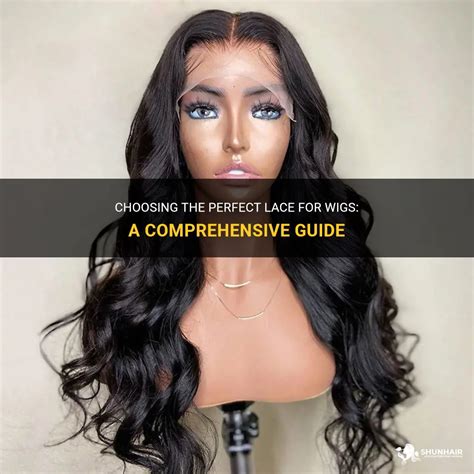Adhesive lace wigs have revolutionized the hair industry, offering unparalleled versatility and natural-looking results. Whether you’re seeking a temporary style change or a long-term solution for hair loss, these wigs provide an innovative alternative to traditional hairpieces. This comprehensive guide will delve into everything you need to know about adhesive lace wigs, from choosing the right wig to applying and maintaining it for optimal wear.

Understanding Adhesive Lace Wigs
Adhesive lace wigs are constructed from a sheer lace cap with human or synthetic hair knotted onto it. The lace cap creates a virtually invisible hairline, allowing the wig to seamlessly blend with your natural hair. The adhesive used to secure the wig is a medical-grade bonding agent that provides a strong and durable hold.
Key Benefits of Adhesive Lace Wigs
- Natural appearance: Adhesive lace wigs blend effortlessly with your natural hairline, resulting in an incredibly realistic look.
- Versatile styling options: These wigs offer endless styling possibilities, allowing you to experiment with different hairstyles without damaging your own hair.
- Long-lasting wear: With proper care and maintenance, adhesive lace wigs can last up to six weeks.
- Comfortable fit: The thin lace cap and breathable materials ensure a comfortable fit that’s barely noticeable.
- Convenient and time-saving: Adhesive lace wigs eliminate the need for daily styling, saving you time and effort.
Choosing the Right Adhesive Lace Wig
Hair quality
Adhesive lace wigs come in various hair qualities, including Remy human hair, non-Remy human hair, and synthetic hair. Remy human hair is considered the highest quality, providing the most natural look and feel. However, it also comes with a higher price tag. Non-Remy human hair is a more affordable option, while synthetic hair is the most budget-friendly yet tends to have a less natural appearance.
Color and length
Choose a wig that matches your natural hair color and length as closely as possible. If you’re unsure of your hair color, consult a professional hairstylist. A wig that is too short or too long may look unnatural.
Cap size
Adhesive lace wigs come in different cap sizes to accommodate various head shapes and sizes. Measure your head circumference before purchasing a wig to ensure a snug fit.
Style
Consider what hairstyle you desire when choosing an adhesive lace wig. You can opt for straight, curly, or wavy hair in various lengths and textures.
Applying and Maintaining an Adhesive Lace Wig
Preparation
Thoroughly wash and dry your hair. Remove any product residue or oils, as they can interfere with the adhesive’s bond.
Applying the adhesive
Use a small brush or cotton swab to apply a thin layer of adhesive to your scalp along your hairline. Avoid applying the adhesive directly to your hair, as it can damage it.
Placing the wig
Carefully place the wig onto your head, aligning it with your natural hairline. Gently press the wig down to secure it.
Maintenance
Avoid washing or styling your wig too often, as it can weaken the adhesive bond. When you do wash it, use a gentle shampoo and conditioner specifically formulated for wigs. Air-dry the wig completely before applying it again.
Common Mistakes to Avoid
Overapplying adhesive
Using too much adhesive can create a thick, uncomfortable bond that can damage your hair and scalp.
Not cleaning your wig
Regularly cleaning your wig is essential to maintain its hygiene and prevent product buildup.
Sleeping with a wet wig
Going to bed with a wet wig can lead to mildew and damage. Always make sure your wig is completely dry before sleeping.
Using the wrong adhesive
Not all adhesives are suitable for use with adhesive lace wigs. Use a specifically formulated medical-grade adhesive to prevent hair damage and allergic reactions.
Pros and Cons of Adhesive Lace Wigs
Pros:
- Natural appearance
- Long-lasting wear
- Versatile styling options
- Convenient and time-saving
- Can conceal hair loss or thinning hair
Cons:
- Can be expensive
- Requires regular maintenance
- May cause scalp irritation or allergic reactions in some cases
- Difficult to remove without professional assistance
Inspiring Applications for Adhesive Lace Wigs
Adhesive lace wigs offer a plethora of applications beyond traditional hair replacement. By customizing and styling these wigs, you can unlock countless creative possibilities:
Cosplay and special effects
Adhesive lace wigs can transform you into any character or creature, making them ideal for cosplay and special effects makeup.
Fashion and runway shows
Fashion designers and hairstylists often use adhesive lace wigs to create unique and avant-garde looks.
Medical and therapeutic use
Adhesive lace wigs can provide a discreet and comfortable hair solution for individuals undergoing chemotherapy or experiencing hair loss due to medical conditions.
Additional Tips and Tricks
- Use a wig cap to protect your natural hair and create a smoother base for the wig.
- Invest in a wig brush designed specifically for lace wigs to avoid snagging or tangling.
- Store your wig in a cool, dry place when not in use to prolong its lifespan.
- Consult a professional hairstylist for help with choosing, applying, and maintaining your adhesive lace wig.
Conclusion
Adhesive lace wigs have become an invaluable tool in the world of hair transformation. With their natural appearance, versatility, and long-lasting wear, they offer a multitude of benefits for those seeking to enhance their hair or conceal hair loss. By understanding the key aspects of adhesive lace wigs and following the tips and tricks outlined in this guide, you can confidently embrace the endless possibilities they offer.
